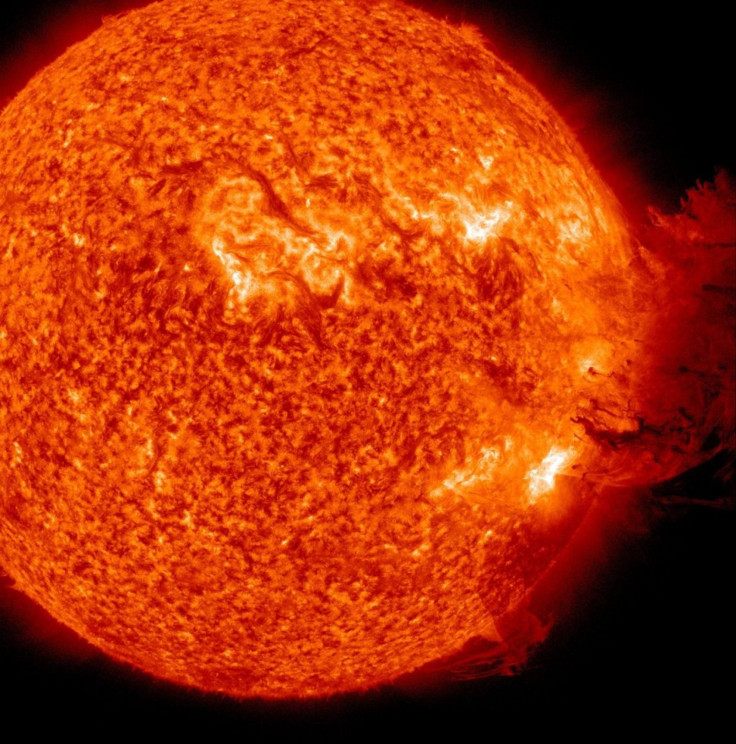Biggest Solar Flare in Years Erupts, to Blow Earth's Magnetic Field

A biggest solar flare in four years erupted from the Sun on early Tuesday, which is heading towards Earth and could disrupt power grids and satellites. The flare was a different kind as it started out slow, then the sun blasted it off like a volcanic eruption.
A sunspot complex on the solar surface became unstable and erupted, resulting in an M2-class solar flare, a, S1-class radiation storm and a spectacular coronal mass ejection (CME). The radiation storm has a minor impact on the high frequency radio in the polar regions.
NASA's solar dynamics observatory (SDO) observed the solar flare peaking at 1:41 am ET on Tuesday. It has also spotted the iconic surfer's wave, which holds clues as to how energy moves through the atmosphere known as corona, rolling through the atmosphere of the sun.
One of the biggest questions about the solar corona is the heating mechanism. The corona is thousand times hotter than the sun's visible surface, but what heats it up is not well-understood. People have suggested that waves like this might cause turbulence which cause heating, but now we have direct evidence of Kelvin-Helmholtz waves, said Leon Ofman, solar physicist of NASA’s Goddard Space Flight Center, Greenbelt, Maryland and Catholic University, Washington.
The CME, travelling faster at 1,400 km/s, should deliver a glancing blow to Earth's magnetic field during the late hours of Wednesday or Thursday, which could disturb Earth's power grids and global positioning systems that heavily rely on satellite communications.
The National Oceanic and Atmospheric Administration's (NOAA) space weather prediction center expects the flare to cause G1 (minor) to G2 (moderate) levels of geomagnetic storm activity Wednesday, beginning around 1800 UTC (1 pm EST) with the passage of a fast CME. But the center revised its prediction for Geomagnetic Storm activity, now expecting the CME to pass Earth around 1200 UTC (7 pm EST) on June 9.
The center said a prompt Solar Radiation Storm reached the S1 (minor) level soon after the impulsive R1 (minor) Radio Blackout at 0641 UTC. The Solar Radiation Storm includes a significant contribution of high energy (>100 MeV) protons, the first such occurrence of an event of that type since December 2006.
But the center revised its prediction, and now expects primarily G1 (minor) NOAA Scale levels, and for the storm to persist for 24 hours. The intensity of the Solar Radiation Storm is expected to be little affected by the passage of the CME-driven shock.
High-latitude sky watchers should be alert for Auroras or Aurora Borealis, also known as Northern lights, which are created as a result of some natural mechanism between solar wind, ions flow, Earth's magnetic field and collisions between ions and atmospheric atoms and molecules that cause energy releases in the form of colorful lights. The aurora borealis (Northern Lights) and aurora australis (Southern Lights) will likely be visible in the late hours of June 8 or 9.
The Geophysical Institute of the University of Alaska Fairbanks predicts higher auroral activity tonight. It would be visible overhead from Barrow to Bethel, Dillingham and Ketchikan, and visible low on the horizon from King Salmon, and visible on the northern horizon on a line from Portland Ore, southern Nebraska, southern Indiana, to Washington, DC.
For the Northern Hemisphere, the aurora should be visible mainly in North America, since the sun is illuminating most of the auroral zone in Russia and Scandinavia. If the timing is right, the disturbance will lead to auroras visible from the Northern US on Wednesday night, the institute predicted.
For Thursday, the institute predicts higher auroral activity that would be visible overhead from Inuvik, Yellowknife, Rankin and Igaluit to Juneau, Edmonton, Winnipeg, Thunder Bay and Sept-Iles. The visibility might be low on the horizon from Seattle, Des Moines, Chicago, Cleveland, Boston, and Halifax.
For Friday, the institute expects moderate auroral activity that would be visible overhead from Inuvik, Yellowknife, Rankin, and Igaluit to as far south as Whitehorse, Ft. McMurray, James Bay. The visibility might be low on the horizon as far south as Prince Rupert, Calgary, Minot, Bemidji, Stevens Point, Traverse City and Quebec City, Canada.
© Copyright IBTimes 2025. All rights reserved.





















